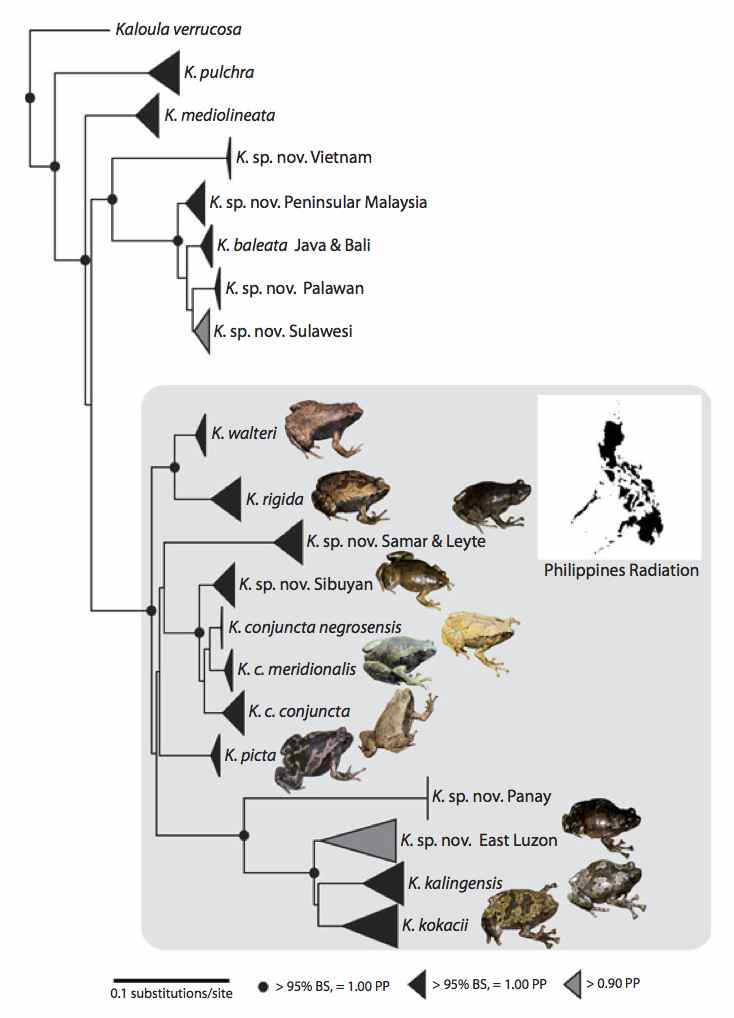Southeast Asian Island Frogs

Adaptive radiations are the rapid accumulation of new species accompanied by adaptation to a diversity of habitats and environments that have specific requirements for habitation. This adaptation is typically observed through different corresponding physical changes. By broadly framing evolutionary radiations as the accumulation of both lineages and observable characteristics, comparisons among groups become focused not on the absolute number of lineages or specific characteristics but rather on the tempo and mode of speciation and the evolution of these observable characteristics. Studies of adaptive radiations focus specifically on lineage accumulation and breadth of physical characteristics.
Most groups of living amphibians continue to receive little attention. Though amphibians have a huge amount of species diversity, and there has not been much research on amphibian radiations. Amphibians in different habitats usually look different or have some measurable, observable difference, and have a high probability of diverging into different species because of their inability to move long distances and tendency to stay in their home ranges. Because of these things we believe adaptive radiations are common among amphibians. Tropical plethodontid salamanders represent a radiation into many different forms related to the habitats in which they are located. Few studies of amphibian adaptive radiations have explicitly described the relationship between use of habitat and physical differences, or examined the accumulation of observable diversity through time. Historically, life history and reproductive modes are seen as integral to adaptive radiation in amphibians.
Here we characterize a group of Philippine frogs as an adaptive radiation. We describe the relationships of frogs in the genus Kaloula (family Microhylidae), assess the relationships between habitat specialization and differences in physical traits, and characterize the accumulation of lineages and physical forms. In this genus there are frogs that are ground specialists, climbing shrub specialists, and tree-hole specialists. We can infer that a single group of Kaloula diversified rapidly following colonization of the Philippines. We demonstrate that variation in physical characteristics within this genus is partly explained by habitat specialization and that during its diversification this group remained distinctly different from others for quite some time.
Results showed that rapid accumulation followed colonization of the Philippines. The models showing the most likely history of radiation are those with increasing diversity and changes in speciation rate through time. There were 12 species-level lineages for Kaloula only found in the Philippines, and this is about equal to the number of Kaloula species found elsewhere in southern Asia. All of the habitat specialists found in the Philippine radiation Kaloula are also found outside of it. This shows that frogs under similar conditions evolve to deal with them in similar ways.
This pattern observed for Philippine Kaloula shows that radiation often occurs largely as a result of a species evolving to taking advantage of unexploited resources and habitats, particularly in island systems. It is possible that the opportunities available to microhylids differ from those of other frogs and toads, which would mean Kaloula had a great opportunity to diversity and radiate when they got to the Philippines.
–Tucker Walton
Blackburn, D.C., C.D. Siler, A.C. Diesmos, J.A. McGuire, D.C. Cannatella, and R.M. Brown. 2013. An adaptive radiation of frogs in a Southeast Asian island archipelago. Evolution 67(9): 2631–2646. pdf
